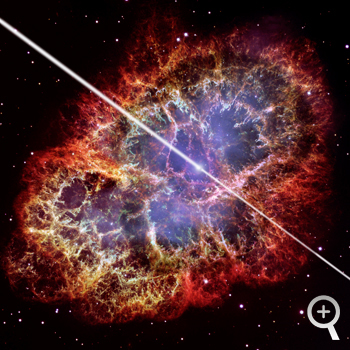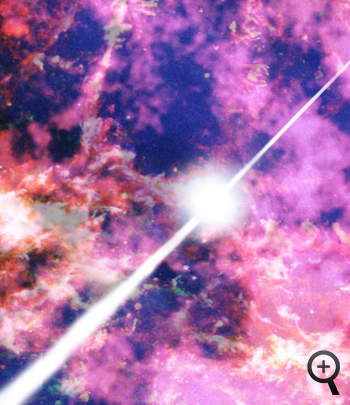Posted 10 October 2011
Crab pulsar beams most energetic gamma rays ever detected from a pulsar
Astrophysicists have detected gamma-ray emission from the Crab pulsar at energies far beyond what they expected. The findings published in Science offer a new avenue for testing Einstein's theory of special relativity, which says that the speed of light is a universal constant.
The Crab Pulsar is a rapidly spinning neutron star discovered in 1968; the collapsed core of a massive star that exploded in a spectacular supernova in the year 1054, leaving behind the brilliant Crab Nebula, with the pulsar at its heart.

An artist's conception of the plusar at the center of the Crab Neulba, with a Hubble Space Telescope photo of the nebula in the background. Researchers using the Veritasa telescope array have discovered pulses of high-energy gamma rays coming from this object. Credit: David A. Aguilar / NASA / ESA
It is one of the most intensively studied objects in the sky. Rotating about 30 times a second, the pulsar has an intense, co-rotating magnetic field from which it emits beams of radiation. The beams sweep around like a lighthouse beacon because they are not aligned with the star's rotation axis. So although the beams are steady, they are detected on Earth as rapid pulses of radiation.
The surprising gamma-ray pulses, with energies exceeding 100 billion electron-volts (100 GeV), were detected by the VERITAS telescope array at the Whipple Observatory in Arizona.
VERITAS is an international collaborative team of 95 scientists from 26 institutions around the world including Irish researchers based in University College Dublin (UCD), NUI Galway (NUIG), Cork Institute of Technology (CIT), and Galway Mayo Institute of Technology (GMIT). The Irish scientists are funded by Science Foundation Ireland.
According to Nepomuk Otte, a postdoctoral researcher at the University of California, Santa Cruz, the corresponding author on the scientific paper, some researchers thought it was crazy to even look for pulsar emission in this energy realm.
"It turns out that being persistent and stubborn helps," said Otte. "These results put new constraints on the mechanism for how the gamma-ray emission is generated."
Otte, Andrew McCann of McGill University in Montreal, and Martin Schroedter of the Smithsonian Astrophysical Observatory performed most of the analytic work for the study.
 This artist's conception shows the Crab Nebula pulsar, which astronomers discovered to be sending out pulses of gamma rays with energies exceeding 100 billion electron-volts (100 GeV). A pulsar is a spinning neutron star - the collapsed core of a massive star that exploded as a supernova.
Credit: David A. Aguilar (CfA)
This artist's conception shows the Crab Nebula pulsar, which astronomers discovered to be sending out pulses of gamma rays with energies exceeding 100 billion electron-volts (100 GeV). A pulsar is a spinning neutron star - the collapsed core of a massive star that exploded as a supernova.
Credit: David A. Aguilar (CfA)
VERITAS spokesperson Rene Ong, professor of physics and astronomy at UCLA, credited Otte as the leading advocate for using the powerful gamma-ray observatory to study the Crab pulsar.
"To me it's a real triumph of the experimental approach, not going along with the flow and making assumptions, but just observing to see what there is. And low and behold, we see something different than what everybody expected," he said.
Dr. John Quinn from the UCD School of Physics, who leads the VERITAS group at UCD, said: ”This is a very significant moment for the Irish scientists involved in the VERITAS project, as they have participated in the search for such gamma-ray emission from the Crab Pulsar and other objects for over 20 years using facilities at the Whipple Observatory.”
Scientists have long agreed on a general picture of what causes pulsar emission. Electromagnetic forces created by the star's rapidly rotating magnetic field accelerate charged particles to near the speed of light, producing radiation over a broad spectrum. But the details remain a mystery.
Prior to these new results, a phenomenon known as curvature radiation was the leading explanation for the Crab's pulsed gamma-ray emission. Curvature radiation is produced when a high-energy charged particle moves along a curved magnetic field. But according to Otte, this mechanism cannot account for gamma rays with energies above 100 GeV.
VERITAS (Very Energetic Radiation Imaging Telescope Array System) is a ground-based observatory for gamma-ray astronomy located at the Fred Lawrence Whipple Observatory in southern Arizona. It is an array of four 12-meter optical reflectors, used to record Cherenkov radiation created by high-energy gamma-ray showers in the atmosphere. These imaging Cherenkov telescopes have maximum sensitivity in the energy range from 100 GeV to 10 TeV (10,000 GeV or 10 trillion electron volts).
This research is supported by the U.S. Department of Energy Office of Science, U.S. National Science Foundation, the Smithsonian Institution, NSERC (Canada), STFC (U.K.) and Science Foundation Ireland.
The researchers from the UCD School of Physics who are part of the VERITAS group that published the findings include: Dr. John Quinn (PI), Anna Cannon (PhD student), Edward Collins-Hughes (PhD student), and John E. Ward (PhD student).
(Produced by UCD University Relations)

